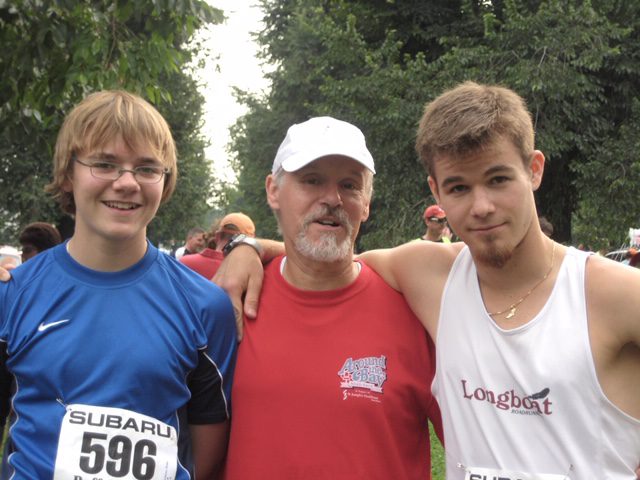How TB turned me into a runner
After a struggle with tuberculosis when he was in high school, Tim Uuksulainen discovered running, and he's been in love with the sport ever since
 Photo by:
Tim Uuksulainen
Photo by:
Tim Uuksulainen
I stood numb in front of my school locker and slammed it shut, the sound echoing down the empty hallway. I wondered what the heck was happening with my life. It was September 1968 and the start of another school year. I was starting Grade 11 at Toronto’s Monarch Park Secondary School, but here I was on my way to the Weston Sanatorium Hospital. A day earlier, I had attended the Gage Institute with my mother, where they shocked us with the news that I had tuberculosis on three lobes of my lungs. They said I was contagious and would have to be admitted to the hospital for treatment. No time to think or say goodbye to friends or schoolmates. Little did I realize that this experience would transform my life and my outlook, and lead to a lifelong passion for running.
https://www.instagram.com/p/BgNUO8MFJvT/?utm_source=ig_web_copy_link
I took the taxi with my mother to the hospital. We didn’t talk too much. I think both of us were in denial. My thoughts floated back to a few days earlier when I had been at the Canadian National Exhibition with two friends, enjoying the last day of the Ex. My life had taken a sharp turn, destination unclear.
RELATED: Need a reason to run more? Exercise linked to a longer life, study finds
I was admitted to my new life at the hospital, where I would remain until May 1969. I soon settled into a boring routine of TV, playing cards, cribbage, taking Grade 11 courses by correspondence and oh, yes, a daily round of 32 pills and one painful injection in my hip. Most of my fellow patients were Indigenous, elderly or very young. It seemed the world had forgotten about me except for my weekly visits by family and few friends. I had access to walk outside on the hospital grounds, and there was one movie night a week, but for an active teenager, it felt like a prison. The fall soon faded to the grey and cold of winter and spring seemed like an eternity away. Finally, in early May, I got the news that I was well enough to return home and resume school.
https://www.instagram.com/p/BR-_swagD9j/?utm_source=ig_web_copy_link
Before my hospitalization I had been active playing soccer and hockey. The many months of hospital stay, inactivity and weight gain left me feeling totally out of shape. This was confirmed a few weeks later when friends invited me to play hockey. My first shift didn’t last long, as I had to return to the bench gasping for breath and ready to heave my dinner. I did finish the game, but I felt very uncomfortable.
RELATED: Longboat Roadrunners honour their namesake’s legacy in myriad ways
Afterward, sitting at home, several thoughts came to mind. Firstly, the realization: I was in lousy shape. Secondly, I had just recovered from a serious illness, one that likely would have killed me, had it occurred a few decades earlier. Thirdly, I thought of a good high school buddy named Ed North who had been trying to get me to join him on the cross-country team for ages — something I had consistently resisted. What’s the purpose of running? I wondered to myself. Some might have called it an epiphany, but whatever it was, in that moment, I realized that all of those thoughts fit together perfectly.

So the next morning, in June 1969, I stepped outside in my cut-off jeans, T-shirt and Dart running shoes and humbly covered two kilometres in a walk/run manner around the park at Coxwell and Eastern Avenues, beginning my lifelong journey as a runner. I would repeat that ritual four to five times a week, working up to 5K. That fall I joined the cross-country team and realized I had found an activity I truly loved. I was fortunate to have a great early teacher/mentor/coach in Andy Higgins, who instilled a philosophy that every individual is important, and while cross-country was a team sport, we are all an experiment of one. Our goals are personal, and we need only to achieve the best we can and not compare ourselves to others. While performance mattered, Andy felt that it is our ongoing journey of maintaining fitness and health that we hopefully carry into adulthood that is our ultimate goal. If we can pass on these goals to others, even better.
RELATED: Vancouver runner describes COVID-19 experience
It has been 51 years since I ran those first steps. In tangible terms, that’s 162,000 kilometres covered and 852 races completed (including 30 marathons) that have taken me to destinations I may never have contemplated otherwise, plus the many friends and teammates I have made over the years. For someone who never considered himself an athlete, I feel happy to have achieved times I am proud of: 14:58 for 5K, 31:15 for 10K, a 1:11:40 half-marathon and a 2:32:28 marathon. But my greatest joy has been to instill the love of staying active and fit to my two sons Erik and Kiefer, and coaching the many hundreds of runners to personal excellence over my 40 years as a coach at the high school, club and university levels. As I’ve often said, adversity isn’t something we should fear, but rather embrace. It is during those moments of adversity that the greatest personal lessons are learned.
Tim has been an active runner since 1969. He helped co-found the Longboat Roadrunners, where he served as the club’s first head coach from 1981-1990, and he has also coached the Nipissing and Ryerson University cross-country teams.


